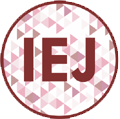Analisis Uang Wariq Dalam Sosiologi Ilmu Pengetahuan
DOI:
https://doi.org/10.21111/iej.v5i1.3667Keywords:
Dinar, dirham, wariq, sociological theory of scienceAbstract
The current facts have shown that the sharia economic growth trend in Indonesia continues to increase, both on a macro and micro scale. That can happen through massive programs of education and sharia economic exhibitions in the midst of the academic community and the general public, as well as increasingly raising awareness of Muslims about the application of sharia in the economic field. The progress of Islamic finance seems to be inseparable from the use of exchange instruments, namely money made from gold and silver or commonly referred to as Dinar and Dirham money. It is in this context that some sharia economists have revived the use of dinars and dirhams as an alternative solution to the problem of modern banknotes. On the same occasion, in some literature, classical fiqh was allegedly a history of wariq money that had existed in Islam even long before the presence of Islam was seen by the Prophet. Wariq money was explicitly approved in the story of the faithful youth of the cave dwellers which were published in the Qur’an Surat al-Kahf verse 19. This study aims to: (1) get a complete picture of the concept of wariq money, and (2) to reveal the relevance of wariq money to sharia economics.The type of research used in this study is literature research with historical studies and reading texts from various classical and contemporary fiqh. In this context, the reference sources offered are a number of fiqh books from among the four fiqh schools which have been selected from the library collection of the Universitas Darussalam Gontor Primary School. To get complete data is done by the screening process and analysis of wariq terms from some of the fiqh books. Screening and analysis is done by collecting various primary references related to the discussion of the wariq, so as to enable a complete description of the term money wariq. This data is then processed and analyzed with the sociological theory of science to be approved by the validity of the overall money concept. The conclusions obtained from this study, wariq money is money made from silver in the form of sheets of paper that have been around since the time of kahfi ashabul. Second, wariq money is very relevant to be used as an alternative solution for the consideration of finance and state finances.References
al-Amali, Muhammad ibn Jarir ibn Yazid ibn Kathir bin Galib. 2000. Jami’ al-BayÄn fi Ta’wil al-Qur’an. Beirut: Mu’assasat al-Risalah.al-Jammal, Muhammad Abdul Mun’im. 1992. Ensiklopedia Ekonomi Islam Jilid 2. terj. Abdullah, Salahuddin. Kuala Lumpur: Dewan Bahasa dan Pustaka.al-Qardlawi, Yusuf. 1973. Fiqh al-Zakat. Damaskus: Muassasat ar-Risalah.al-QurtÌ£ubi, Abu al-Walid Muhammad ibn Ahmad ibn Rashad, 1988. Zakat al-Dzahab wa al-Waraq. Beirut: Dar al-Garbi al-Islmi.al-Ramini, Muhammad ibn Muflih ibn Muhammad ibn Mufraj, Abu ‘Abdillah, Shams al-Din al-Maqdisi. 2003. al-Furu’ wa Ma’ahu Tashih al-Furu’ li ‘ala’ al-Din ibn Sulayman al-Mardawi. Beirut: Muassasat al-Risalah.al-Sijistani, Abu Dawud Sulayman ibn al-Ash’ath ibn Ishaq ibn bashir. Sunan Abi Dawud Juz III. Beirut: al-Maktabah al-‘Asriyah.Burhanuddin, Ibrahim ibn Muhammad ibn ‘Abdillah ibn Muhammad ibn Muflih, Abu Ishaq. 1404 H. al-Naktu wa al-Fawa’id al-Saniyah ‘Ala Mushkil al-Muharrar Li Majd al-Din ibn Taymiyah.RiyadÌ£: Maktabah al-Ma’arif.Chapra, M. Umer. 1996. "Monetary Management in An Islamic Economy." Islamic Economic Studies. 4(1), 1-35Departemen Agama Republik Indonesia. 1985. Al-Qur’an dan Terjemahan. Jakarta: DEPAG RIFaiz, Ihda A. 2010. "Ketahanan Kredit Perbankan Syariah Terhadap Krisis Keuangan Global," La_Riba, Jurnal Ekonomi Islam. 4(2), 217-237Fatwa Dewan Syari’ah NasionalNo. 77/DSN-MUI/VI/2010.TentangJual-Beli Emas Secara Tidak Tunai.Firdaus, Rachmat dan Maya Ariyanti. 2011. Pengantar Teori Moneter serta Aplikasinya pada Sistem Ekonomi Konvensional dan Syariah. Bandung: AlfabetaGilarso, T. 1976. Dunia Ekonomi Kita. Yogyakarta: Penerbit Yayasan Kanisius.Hamid, Edy Suandi. 2009. "Akar Krisis Ekonomi Global dan Dampaknya Terhadap Indonesia," Jurnal Fakultas Hukum UII. 3(1), 1-11Hasan, Ahmad. 2004. Mata Uang Islami. Jakarta: PT Raja Grafindo Persada.Johnson, Doyle Paul. 1986. Teori Sosiologi Klasik. Jakarta: Gramedia Pustaka Utama.Judisseno, Rimsky K. 2005. Sistem Moneter dan Perbankan di Indonesia Jakarta: PT Gramedia Pustaka Utama.Karsidi, Ravik. 2005. SosiologiPendidikan. Surakarta: Penerbit UNS Press dan LPP UNS.Kolip, Elly M. Setiadi dan Usman. 2011. Pengantar Sosiologi. Jakarta: Penerbit Kencana.Manzur, Ibn. 2003. Lisan al-‘Arab. Cairo: DÄr al-Kutub al-HadÄ«th.Mishkin, Frederic S. 2004. The Economics of Money, Banking, and Financial Markets, 7th edition. Boston: Publisher Pearson Addision Wesley.Nasution, Mustafa Edwin, dkk,. 2010. Ekonomi Islam: Pengenalan Eksklusif. Jakarta: Penerbit Kencana.Soekamto, Soerjono. 1986. Sosiologi: Suatu Pengantar. Jakarta: Penerbit CV. Rajawali.Umam, Khoirul. 2015. "Perilaku Permintaan Uang Islam: Antara Otentisitas dan Inovasi.†Islamic Economics Journal. 1 (1)Wikipedia: Ensiklopedia Bebas. 2016. "Dikyanus," sumber: https://id.wikipedia.org/wiki/Dikyanus, diakses pada tanggal 06 November 2016.Wulansari, C. Dewi. 2013. Sosiologi: Konsep dan Teori. Bandung: Penerbit Refika Aditama.Zallum, Abd al-Qadim. 2002. Sistem Keuangan di Negara Khilafah, terj. Ahmad S, dkk. Bogor: Pustaka Thariqul Izzah






